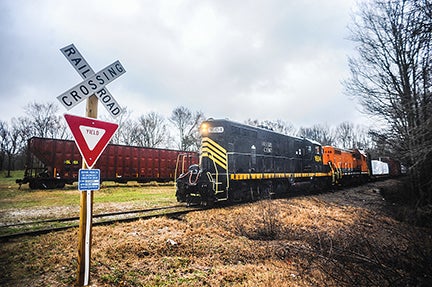Roseburg Forest to close Oxford plant
Published 12:00 pm Thursday, February 25, 2016

- A Mississippi Central Railroad Company train passes through Abbeville, Miss. on Tuesday, February 23, 2016.
Quietly and without much publicity, Forest Roseburg ceased operations in December at its Oxford plant.
A skeleton crew of about four people has been left at the plant to finish closing up shop and getting out remaining preor- dered product. The plant is expected to “go idle” by the middle of March, according to Mark W. Avery, vice president of composites and logistics for Roseburg. The company moved into Oxford in 2006 after purchasing the former Georgia-Pacific facility on County Road 101. At its strongest, the plant employed about 145 people. Over the years, that number dropped down to 50 in 2013. By the time the decision to close the plant was made, only 22 hourly and six salary workers were employed at the
wood-product manufacturing plant. Roseburg owns the plant and the property it sits on. Avery said most of the remaining workers retired when the decision to cease operations was made.
“We’ve been looking at better uses for the property but haven’t uncovered anything yet,” Avery said. “Short-term plans are to get the remaining product out and evaluate our options, which could include potentially selling the property.”
Oxford and Lafayette County Chamber of Commerce President and CEO Jon Maynard said the Economic Development Foundation has stayed in contact with Roseburg.
“We stand ready to support their decision on how to repurpose or dispose of the Oxford facility,” Maynard said. “While we are disappointed in the cessation of operations, this presents a new set of opportunities for Lafayette County.”
Avery said the Oxford plant, which made laminated wood products, had three main customers. Their biggest customer decided to do their own lamination and the Oxford plant lost 85 percent of its orders. The remaining two cus- tomers have been integrated into Roseburg’s Montana and Louisiana plants.
To ship its heavy, wood product, Roseburg used freight trains to transport material. It is the only industry in Lafayette County that still used the railroad to transport goods.
Now, with Roseburg closing, the sound of a train whistle and the rumble of freight cars also will be ceasing.
“We were the only stop on that line,” Avery said. “No one else is picking up or putting out freight.”
Rail service pre-dates Civil War
The Mississippi Central Railroad Co., a subsidiary of Pioneer Railcorp, operates 51 miles of track from Oxford to Grand Junction, Tennessee; 11 miles in Iuka and 46 miles from Corinth to Red Bay, Alabama.
Engineer Robert Riley has rode the train into Oxford for seven years. The train goes from Oxford to Holly Springs to Grand Junction where it’s carried out to Illinois.
“I come into Oxford about once a week,” Riley said. “That’s fixin’ to change though. March 4 is the last time we’ll come down here.”
Family tradition
Riley’s great, great-grandfather rode the same train from Jackson to Corinth when he headed out to fight for the Confederates in the American Civil War with the 16th Infantry Company B.
“He wrote a journal during the Civil War and he made mention of riding this railroad,” said Riley, who lives in Coldwater.
In 1852, the Mississippi Central Railroad was chartered by the Legislature to build a railroad from Canton to Grand Juntion that would pass through Water Valley, Grenada, Oxford and Holly Springs.
In 1862, Gen. Ulysses S. Grant began the Mississippi Central Railroad Campaign during the Civil War where he established base in Holly Springs and advanced south along the railroad. Confederates eventually dam- aged a railroad trestle and lead a successful ambush at Oakland that stalled the Union advance. Gen. Earl Van Dorn lead a successful ambush at the supply base in Holly Springs and destroyed the railroad.
Post-Civil War
After the war, the railroad was rebuilt and was acquired by the Illinois Central Railroad in 1872, which was headquartered in Water Valley. Famed
engineer Casey Jones regularly operated passenger trails along the line. In 1993, the Pioneer Railcorp purchased the line and resurrected the name Mississippi Central Railroad.
In the mid-2000s, the entire track south of The Airport at Ole Miss was abandoned and the airport runway expand- ed over the right of way. The tracks now end at the airport’s perimeter fence. The remaining abandoned right-of-way has been turned into two different rail trails — the Oxford Depot Trail and Thacker Mountain Rail-Trail.
“There’s a lot of history to this rail,” Riley said.
Nathan Johns, vice president of marketing and government affairs for Mississippi Central Railroad Co. said while the train will no longer come into Lafayette County for now, that could change in the future.
“Best case, another rail user moves into Oxford and begins shipping via the MSCI again,” he said. “Worst case, we use it for storage cars until a new user comes along. Either way, the line will remain active for the foreseeable future — it will just have less visible activity on it than it does today with Roseburg shipping.”
Riley hopes for the best- case scenario so the trains will again rumble through Lafayette County, which helps to keep trucks off local and state highways, he said.
“The average rail car can carry three to four times what a semi-truck can carry,” he said. “Be good if more industries would use the railroad.”





